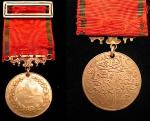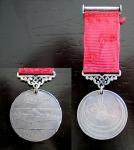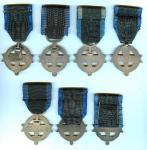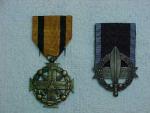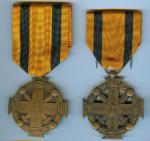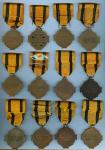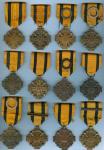-
Posts
136 -
Joined
-
Last visited
Content Type
Profiles
Forums
Blogs
Gallery
Events
Store
Everything posted by makedon
-

Greece - Military Medal of Merits
makedon replied to Tim B's topic in Southern European & Balkan States
Hello Tim, I do not agree with you in this. The manufacture is definetely foreign, probably french as I stated. The only Greek medal that resembles this style is the Cross of Independence, but this was issued in the 1830s and the differences are important. It worths mentioning that the only Greek medals issued during King George I's Reign (1863-1913) were -The Royal Household medals -The medals "For Valor" and "Lifesaving with danger of life " -The Seamen's Fund medal for Saving life at sea and, probably, for services to the merchant navy. All of the above are scarce. Very little is known for the first three- when, why and to whom they were given. -

Greece - Greek Cross from about 1830
makedon replied to Komtur's topic in Southern European & Balkan States
Very nice documents! The Greek one is not an award document, but a document of commission as a Lieutenant-Doctor in the Greek army. Pretty rare and unusual. As opposed to what Kev says, based on Stratoudakis' book, this medal was never issued in iron, in my opinion. There were 6 different medals issued in greece during King Otto's reign (1832-1862). Only two of them were not manufactured in iron at all: -1st Assembly Members' in Epidauros medal (in silver) -The Struggle for Independence medal (silver, bronze and iron) -The Bavarian Volunteers' medal (in bronze) -The Bavarian Auxiliary Corps medal (in iron and bronze) -The Proclamation of Constitution star of Athens 1843 (in iron and bronze) -The Proclamation of Constitution cross 1843 (in iron and bronze) I am attaching another example of the Bavarian Volunteers' medal, without the original ribbon. -
2nd Crete Medal (TarziCedid Girit), 1890 This medal was awarded for the successful suppression of revolts by the Christian population (who constituted a majority) in Crete in 1890. The resulting flood of Christian refugees arriving on the Greek mainland inspired worldwide sympathy for the Greek cause, however, and Abdulhamid II made promises of reforms in order to calm the situation. The suppression of this revolt would prove to be the last successful campaign in Crete by the Ottoman Empire. In 1896 another uprising was crushed violently by the Ottoman government, resulting in a full-scale Greek invasion of Crete and intervention by European powers. The Empire was forced to grant autonomy to Crete, although Crete still remained nominally a Turkish possession until annexed by Greece during the Balkan wars in 1912. The medal is 23 mm., in gold or silver. The obverse bears the tughra of Abdulhamid II, and the date AH 1308 (1890). The reverse bears the inscription "Medal Specially for the Soldiers of the Ottoman Empire Who Demonstrated Effective and Meritorious Services, as well as Courage and Valor in Crete". The gold class of this medal is one of the rarest Turkish campaign medals, with only about 50 awards. The original ribbon is 20 mm green with narrow red stripes inset from each edge. This appears to have been changed later to a red ribbon with three equal green stripes, as used on the 2nd Yemen and Greek War medals. Finally, there is another, extremely rare 1st Balkan War medal: Cruiser Hamidiye Medal (Hamidiye Kruvazoru Humayunu Madalyasi) 1913 This medal was the only commemorative military medal issued for the Balkan War of 1912-1913. The cruiser Hamidiye and its Captain, Rauf Bey, achieved considerable success in the naval battles of this war, sinking several Greek ships and defending the Aegean and Adriatic waters of Turkey. Although the outcome of the war as a whole was a failure for the Ottoman Empire, the exploits of this one ship achieved enough fame to merit this medal. The medal was struck only in bronze, 31.5 mm in diameter, and was awarded to the 394 crewmen of the Hamidiye. The obverse bore the tughra of Mehmed Reshad, surrounded by a swirling ornamental design reminiscent of waves. On the reverse is an image of the battle cruiser, below which is an ornamental scroll with a blank space where the name of the recipient was engraved. This award was to be passed to the heirs of the recipient upon his death. The ribbon was red with wide green borders. Next time you come to Greece Alex, e-mail me; it will be my pleasure to meet you! Dimitris (Makedon)
-
Very nice piece! It is the most common of the three Greek-Turkish War medals of the Ottoman period.You can easily find it without suspension, but with a ribbon and the original suspension, it is pretty rare. Avsar is a well known dealer and collector, always helpful with the others. He just found two excellent pieces for me, again from Greek-Turkish Wars- the Cretan campaigns of 1869 and 1890. The 1890 medal is the rarest of the three. Again, from www.turkishmedals.net, we get the following information: 1st Crete Medal (Atîk Girid), 1869 Although uprisings among the Greek inhabitants of the island of Crete had been occurring for years, an outright revolt began on May 14, 1866, when a group of Greek citizens demanded lower taxes and changes in the court system. Although their demands were met, Ottoman troops were mobilized immediately, expecting outright rebellion. This became a self fulfilling prophecy, and fighting broke out between Cretan Greeks and Turkish soldiers. Thousands of Greek volunteers arrived on the island from the mainland, and the Greek government appealed to the Western powers to intervene on their behalf. Britain and Austria, however, were opposed to intervention for the time being. Thus, the Ottoman armies achieved one of their most uncompromised victories of the century, settling the affair in 1869. The Empire was able to retain Crete in some form for another 43 years. The medal is silver, 36 mm in diameter, with the tughra of Abdulaziz on the obverse above a crescent, and a panoramic view of the island of crete on the reverse below the word "Girid" (Crete). At the bottom of the reverse is the date 1285 (1869). The original ribbon color is believed to have been solid red. About 50,000 of these medals were awarded.
-

Greece - Devices to Greek ribbon bars
makedon replied to Lukasz Gaszewski's topic in Southern European & Balkan States
Hello Lukas, The spiral devices were meant to be for some Air Force medals, but they were never issued. It would be interesting to see them, if they had ever been manufactured! -

Serbia Online resources for S. European & Balkan States
makedon replied to JimZ's topic in Southern European & Balkan States
Modern Greek Orders and medals http://www.presidency.gr/en/tagmata.htm http://www.army.gr/files/File/ITHIKES_AMOIBES/metallia.pdf http://www.army.gr/files/File/ITHIKES_AMOIBES/parasima.pdf -

Serbia Online resources for S. European & Balkan States
makedon replied to JimZ's topic in Southern European & Balkan States
An excellent reference on Ottoman medals http://www.turkishmedals.net/ -

Serbia Online resources for S. European & Balkan States
makedon replied to JimZ's topic in Southern European & Balkan States
Dear Collectors and friends, I would kindly ask you not to refer to FYROM (Former Yugoslav Republic of Macedonia) as "Macedonia" or "Makedonia", because Macedonia and Macedonians are terms referring to a Greek territory and its inhabitants. Using them for an ex-Yugoslav territory, which was part of southern Serbia (as seen by documents and historical papers before the end of World War II), could possibly mean political propaganda in favor of this newly-formed "nation" and against Greece and the historical truth. I would suggest that everybody uses the official United Nations' and NATO term "FYROM", because as far as I know no political propaganda is allowed in this forum. Finally, as most members share their passion for history, it would be better to show our level of knowledge and learn how to use the proper terms that would not offend the others! All the best from Greece! Dimitris -

GREECE - THE WAR CROSS OF 1916 - 1917.
makedon replied to Kev in Deva's topic in Southern European & Balkan States
Reverse of the above. Check my photos in "Greek military medals" and "WWI medal bars" for War Crosses as parts of medal bars. The last two are often found with the marks "METAL" and "MADE IN FRANCE". They are probably of later manufacture. Does anybody know when the term "MADE IN..." started being used? Note the three different types of suspension: 1) Oval-loop (1,2,3,5) 2) T-like (4) 3) Horizontal (6,7) -

GREECE - THE WAR CROSS OF 1916 - 1917.
makedon replied to Kev in Deva's topic in Southern European & Balkan States
Some Greek War Crosses 1916-17, different variations, in silver and white metal. 1. Sue-Rivaud 2. Zisimou 1st variety 3. Huguenin 4. Unknown 5. Zisimou-2nd variety 6. French manufacture 7. Same french manufacture-different suspension -

Greece - Military Medal of Merits
makedon replied to Tim B's topic in Southern European & Balkan States
The cut-out medal is much thicker than the known versions. I don't know whether we can name it a "veteran's issue" or a private order, but it has a resemblance with a french made War Cross 1916-17. You can see this pair-sorry for the bad quality. They came together as a lot, when I bought them. Check the War Crosses I added in the site. Based on the number of articles and the extensive modern Greek military History, I think it is about time to establish a separate section for "Greece", as there is for other countries, isn't it? -

Greece - Military Medal of Merits
makedon replied to Tim B's topic in Southern European & Balkan States
Convex or vaulted would be a more appropriate term, I guess! But, this also has the dates 1916-17 engraved on the reverse. I have seen it as part of a medal bar (see the attached photo, belonging to General Nikolaos Trikoupis). -

Greece - Military Medal of Merits
makedon replied to Tim B's topic in Southern European & Balkan States
-

Greece - Military Medal of Merits
makedon replied to Tim B's topic in Southern European & Balkan States
-

Greece - Military Medal of Merits
makedon replied to Tim B's topic in Southern European & Balkan States
-

Greece - Military Medal of Merits
makedon replied to Tim B's topic in Southern European & Balkan States
Here are some photos of Greek military merit medals, covering a period from 1917 to 1974. Check the first, curved type, which also comes in white metal and the second, holed one. Both are probably of french manufacture. -
Unfortunately not. Greeks are not famous for their military records...
-
As I saw there is an interest in WWI bars, I start this new topic. This is a Greek WWI medal bar, consisting of: -Gold Cross of Valor (3 awards) -Military Merit medal, 1st or 2nd class-the wreath is missing (1st type-Sue/Rivaud) -1st Balkan War medal with 4 battle bars -2nd Balkan War medal with 3 battle bars -Interallied Victory medal -Serbian Milosh Obilitch gold medal The (unknown) recipient saw action in the Balkan Wars (1912-13), WWI (1917-18) or/and Expedition in Ukraine (1919) and the Minor Asian Campaign (1919-1922). My guess is that he was a high-ranking Officer, who probably had some Redeemer and George I higher awards (Commanders or higher).
-

Greece - Help please ID Ribbon bar
makedon replied to Noor's topic in Southern European & Balkan States
The palm is what normally goes to this one, but we sometimes see all kinds of variations. It could also fit a miniature medal. Again, the Order of Redeemer should come first. -

Greece - Military Medal of Merits
makedon replied to Tim B's topic in Southern European & Balkan States
Hello Tim, It is always nice to see foreigners with an interest on Greek awards. The version without the dates on is usually found on old varieties (such as the Sue-Rivaud or the Huguenin one) and it was probably used during the Minor Asian Campaign 1919-1922, but later on it was decided to leave the initial dates on. SO, we see all Military medal types until 1974 to have them. The thing is that the medals without the dates are NOT different versions. They just took the originals and scratched them! I wouldn't pay more to acquire them. I will try to scan and send you some very interesting and scarce types that are not in the book. Makedon -

Greece - Help please ID Ribbon bar
makedon replied to Noor's topic in Southern European & Balkan States
Hello, You are NOT missing any stars. You are missing two small metallic crowns, bronze, silver or gilt, depending on the class of the War Cross. The group consists of: -Gold Cross of Valor -Commander of the Order of George I -Silver Cross of George I with swords -Gold Cross of George I with swords -War Cross 1940 with 2 devices -Outstanding Acts medal 1940 2nd type -Military Merit medal, 3rd class -1940-41 operations medal I should also recommend that the 3rd award should be 4th and vice versa, plus that the 3rd award's swords should have been silver, I think. -

Greek Victory Medals
makedon replied to Tim B's topic in Inter-Allied Victory Medals of the Great War
Hello Rob! Based on the awards of this group, it probably belonged to a Captain or a Major, having gratuated from the Officers' Academy after 1913, who saw action in: -WWI -Probably expedition in Ukraine (1919) -Minor Asian Campaign The reasons, in my opinion, why we don't find Greek medal bars often are: -Sometimes the Officers and NCOs did not fix the medals together. I often find groups belonging even to high ranking officers, which are completely unmounted. -Even nowadays, families prefer to keep the medals of their ancestors and they are rarely being sold. -Many more decorations have been lost/destroyed during the long period of wars and conflicts in the modern greek history. Another interesting WWI bar that you can find in this page is under "Canada", including Order of Canada and some other Canadian and Greek awards. It obviously belonged to a Greek who, after serving his duty in the late 1910s, immigrated to Canada and became an important contributor of the social and political life there. Makedon -
Hello Nightbreak, The person was most probably a conscript who served his duty during WWI and then immigrated to Canada and became a prominent member of the Greek-Canadian Community. Then it would't have been very hard for him (through his services to the community) to get some more "civilian" awards. Please do not bother to ask-I have already done myself so and their answer was that they would give NO info. Moreover, they told me to tell the owner of this medal bar to RETURN the Order of Canada to their service, because it is the property of H.M. the Queen. I think this is something they should have done upon death of the recipients; or, they could bid themselves on the auctions where these Orders come out, right?? By the way, does anybody have a clue if it is legal to buy or sell an Order of Canada in Canada or the UK and how much would that cost?
-

Greece-Greek pilot's wings pre-WWII
makedon replied to makedon's topic in Southern European & Balkan States
Here is a photo of the back -
Dear collectors, Within the past few years I found these identical pilot badges, that seem to be Greek. One of them even has a number on the lower part of the reverse. I am wondering if anyone could tell for sure whether these two examples are original Greek pilot badges. Has anyone seen them before? is there an expert on world pilot's badges? thank you!




